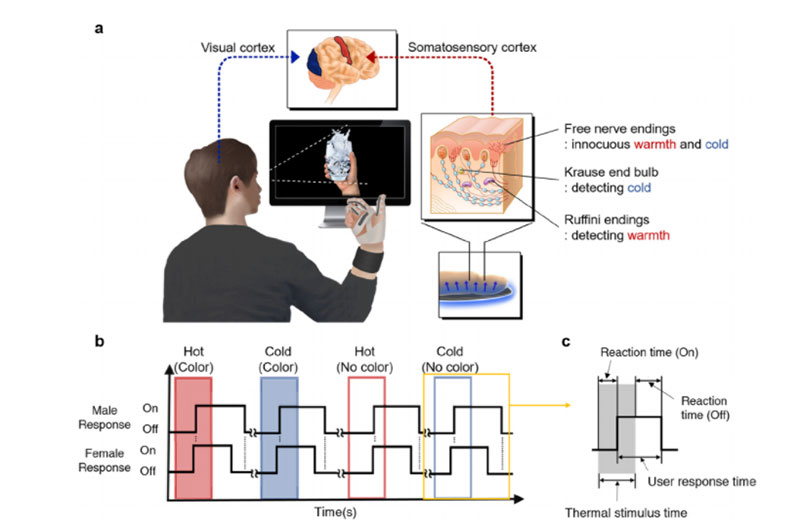We need thermal perception for our daily activities. Therefore, thermal feedback stimulation is needed to improve the sense of realism in virtual reality (VR) for users. Conventional methods to provide thermal stimulus utilize liquid circulation with bulky external sources or thermoelectric devices (TEDs) on rigid structures. These systems are difficult to apply to compact wearable gear used for complex hand motions to interact with VR. Furthermore, generating a rapid temperature difference, especially cooling, in response to a thermal stimulus in real-time is challenging for the conventional systems.
Read more FundamentalVR Integrates Groundbreaking HaptX Gloves on its Fundamental Surgery Platform
Now researchers at the KAIST (Korea Advanced Institute of Science and Technology) have come up with a new novel glove for thermal perception in VR. It is a self-sufficient thermal glove which is designed to enable users to feel virtual temperatures in real-time.
This glove comprised piezoelectric sensors enabling hand motion sensing and flexible TEDs for bidirectional thermal stimulus on skin. The customized flexible TEDs can decrease the temperature by 10 °C at room temperature in less than 0.5 s. Moreover, they have sufficiently high durability to withstand over 5,000 bends and high flexibility under a bending radius of 20 mm. In a user test with 20 subjects, the correlation between thermal perception and the displayed object’s color was verified, and a survey result showed that the thermal display glove provided realistic and immersive experiences to users when interacting with VR.
The system is fully untethered and lightweight, making it easy to wear and allows the user to move freely in any posture. In addition, the flexible TED can display a wide range of temperature within a few seconds. This range of display temperature allows the user to experience a variety of thermal perception in real life from the VR environment, reports Nature.

To test their new glove, the researchers conducted an experiment where the user interacted with several virtual objects with general temperature expectations. The virtual objects were a coke can in a refrigerator (cold), a dog (warm), and a chicken in a microwave (hot). Specifically, we performed three actions with the virtual objects in the virtual space: taking a canned drink out of a refrigerator, freely petting a dog, and grasping a chicken in a microwave.
The results showed that the temperatures of the flexible TEDs were changed when the virtual hand came in contact with the virtual objects at the designated temperatures. Similarly, the flexible TEDs on the glove were cooled when the user took the can out of the refrigerator, mildly heated to achieve a warm feeling when petting the dog, and heated when the virtual hand grasped the chicken. Initially, the flexible TEDs were at a background temperature of approximately 22 °C. In the cold case, the temperature of the flexible TEDs was reduced to approximately 15 °C during contact with the coke can. Moreover, the temperature of the flexible TEDs was changed to 25–28 °C during the interaction with the virtual dog. In addition, the temperature of the flexible TEDs increased to approximately 33–35 °C when the user touched the chicken.
Read more NeoMano Robotic Glove Helps People with Paralyzed Hands to Grip Objects
“We demonstrated that the proposed system can provide varied temperature changes based on the designated thermal state of the virtual object,” the researchers wrote. “During the experiment, the interaction with the cold object decreased the device temperature by approximately 7 °C, the warm object increased the device temperature by approximately 3–6 °C, and the hot virtual object increased the device temperature by approximately 11–13 °C. These three different temperature variations show that the system provides adequate thermal feedback depending on the situation.”












